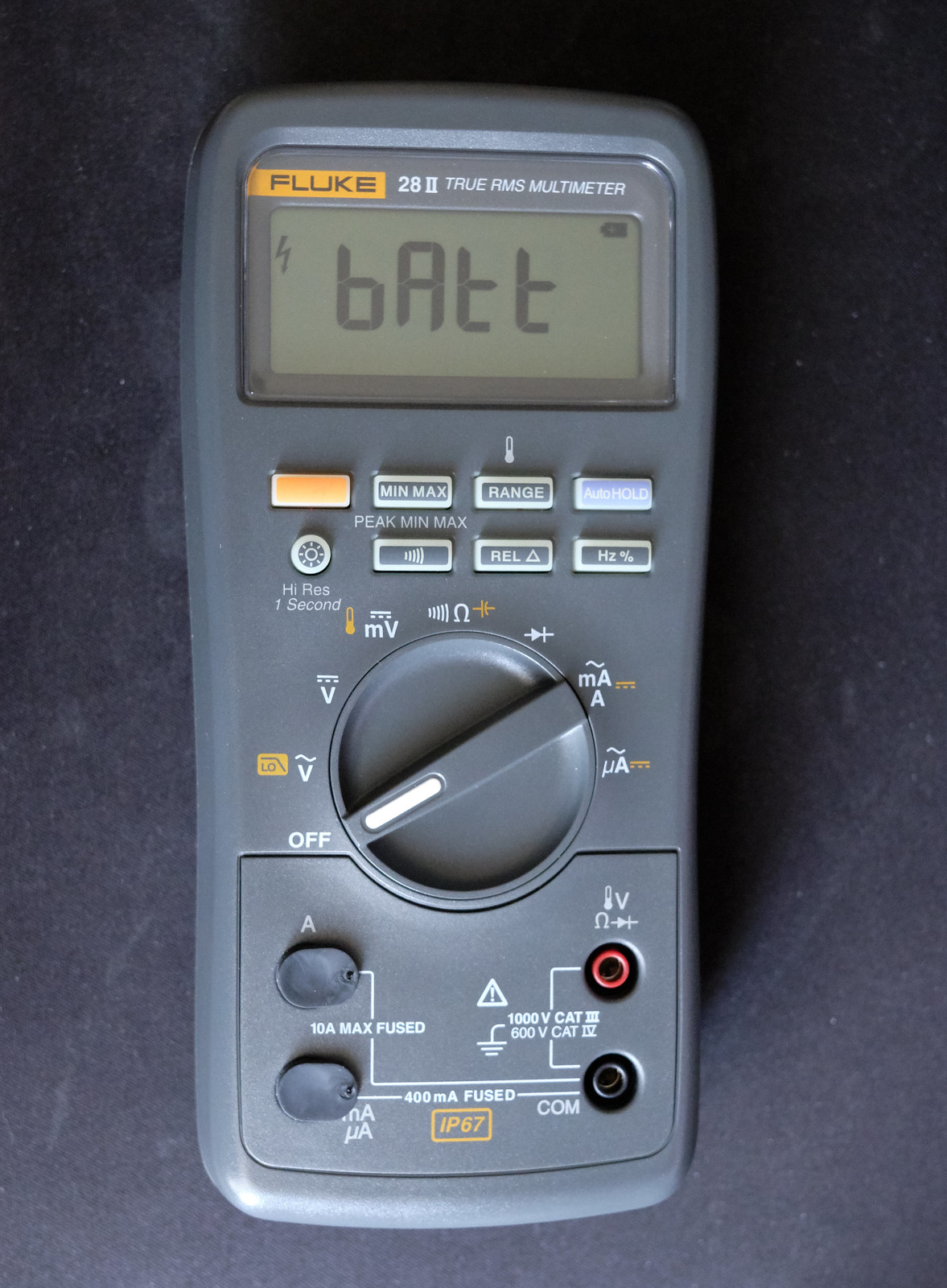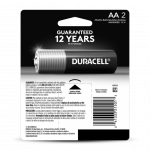My trusty "indestructible" meter decided to give up working last week. As it turns out, one of the original energizer batteries that was supplied from the factory which was still in date had started to leak. Apart from some fractured plastic from the swollen cell, there didn't seem to be any corrosion or ingress of any battery acid. The meter was bought in 2016 and the batteries dated ok until 2025.

Some missing plastic bits but otherwise clean. (I've got the bits which I can glue back in if needed)


What foxes me is why I now see this no matter what new batteries I put in it. Am I doing something wrong or has this killed the meter? Even dafter question is will Fluke warranty this given the battery that leaked was in there from the factory. (this was bought from an authorised supplier by me)


Some missing plastic bits but otherwise clean. (I've got the bits which I can glue back in if needed)


What foxes me is why I now see this no matter what new batteries I put in it. Am I doing something wrong or has this killed the meter? Even dafter question is will Fluke warranty this given the battery that leaked was in there from the factory. (this was bought from an authorised supplier by me)

What is really hiding behind shelf life date ?
If you dont use the battery it will still be usefull ?
If you dont use the battery it will not leak ?
Will never leak before this date ?
Someone should ask ? or someone should answer ?
For myself i am not in the battery buisness ... so I cant answer ....
If you dont use the battery it will still be usefull ?
If you dont use the battery it will not leak ?
Will never leak before this date ?
Someone should ask ? or someone should answer ?
For myself i am not in the battery buisness ... so I cant answer ....
If it goes flat before use, or leaks, before the marked date, you can try to claim on the warranty. I've never tried this.
Leaks happen randomly.
If you USE the battery, it goes flat according to the load, the maker has no control of that.
I keep about $30 of batts in a cool cellar (this IS Maine; ah, you are Quebec, you know), and try not to let them sit more than 3 years. I have not had a real leak in a long time, but have had several "UGHHKK!" disasters with battery springs and circuit boards rotted away, or flashlights so choked with white gunk that I had to drill the dead cells out (and that rarely ends well).
That's not to mention that a lot of battery devices are junk. I have a D-cell flashlight that if you use good-brand batts, the switch is bound-up and won't work. Cheap batts are like 0.050" smaller and the switch works. (I do not know how a cheap flashlight can be so precise.) Since it was also incandescent, it hit the trash. I can buy a fine LED hand-torch with starter cells for much less than an LED replacement bulb, and I don't need D-cells with LEDs for my limited use.
Leaks happen randomly.
If you USE the battery, it goes flat according to the load, the maker has no control of that.
I keep about $30 of batts in a cool cellar (this IS Maine; ah, you are Quebec, you know), and try not to let them sit more than 3 years. I have not had a real leak in a long time, but have had several "UGHHKK!" disasters with battery springs and circuit boards rotted away, or flashlights so choked with white gunk that I had to drill the dead cells out (and that rarely ends well).
That's not to mention that a lot of battery devices are junk. I have a D-cell flashlight that if you use good-brand batts, the switch is bound-up and won't work. Cheap batts are like 0.050" smaller and the switch works. (I do not know how a cheap flashlight can be so precise.) Since it was also incandescent, it hit the trash. I can buy a fine LED hand-torch with starter cells for much less than an LED replacement bulb, and I don't need D-cells with LEDs for my limited use.
Are you sure the clips are making good contact? Bend them all outward a little more.
Also you can try it with a lab supply if that doesn't work.
Also you can try it with a lab supply if that doesn't work.
Check the soldering to the main board from the battery holder.
Also, if possible, replace the wires from battery to PCB, sometimes they corrode internally due to battery fumes (not very likely here).
But a just in case precaution.
There was a thread here about batteries from different brands, and Duracell it seems has a Pro line which is better quality.
You might try those.
Also, if possible, replace the wires from battery to PCB, sometimes they corrode internally due to battery fumes (not very likely here).
But a just in case precaution.
There was a thread here about batteries from different brands, and Duracell it seems has a Pro line which is better quality.
You might try those.
One more thing, the reference circuit may be out of kilter and reporting wrong battery voltage to the meter chip.
Some chips have an external circuit, and some have an internal reference.
You will have to do that effort next.
Unfortunately, continuous low voltage can cause permanent damage to chips...
Some chips have an external circuit, and some have an internal reference.
You will have to do that effort next.
Unfortunately, continuous low voltage can cause permanent damage to chips...
You need to get the oxidized crud off of the negative terminal particularly where it made contact with the leaking battery .
I've never seen that way to do a battery holder. One of the shorting bars is in the cover and one is in the chassis. Was that the way it was originally?
Do as I did.
Contact Energizer Holdings.
Have photos of the leaking batteries, including clear photos of the date and code numbers.
It helps if you have the original packaging too.
If the meter is damaged, they compensate for replacement, along with coupons for new batteries.
I had two packs (16 batteries each) of 1year old Energizers starting to leak still in the package.
Energizer sent me two coupons for $15 each to buy new ones - must have been a bad batch I had.
Contact Energizer Holdings.
Have photos of the leaking batteries, including clear photos of the date and code numbers.
It helps if you have the original packaging too.
If the meter is damaged, they compensate for replacement, along with coupons for new batteries.
I had two packs (16 batteries each) of 1year old Energizers starting to leak still in the package.
Energizer sent me two coupons for $15 each to buy new ones - must have been a bad batch I had.
Probably that's so you cannot operate it without the rear cover.I've never seen that way to do a battery holder. One of the shorting bars is in the cover and one is in the chassis. Was that the way it was originally?
To answer the question as to why the meter has problems, I got curious as the crystallisation had returned in the battery compartment even though there were no batteries left in it. Turns out the leak had sneaked into the inside of the meter bypassing the battery contacts J5 & J6 where I could see the PCB, hence why I thought I'd got away unscathed.

These were batteries were fitted from new, so I'll have to see what Fluke say about this. I had some eneloops sat ready to go in it once the factory batteries started to go flat. Not sure how the energizer warranty stacks up in the UK vs the US. We shall see.

These were batteries were fitted from new, so I'll have to see what Fluke say about this. I had some eneloops sat ready to go in it once the factory batteries started to go flat. Not sure how the energizer warranty stacks up in the UK vs the US. We shall see.
- Home
- Design & Build
- Equipment & Tools
- Fluke 28II battery error
